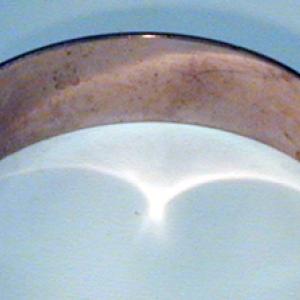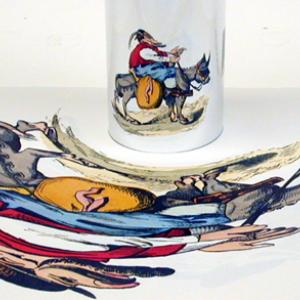College of Liberal Arts & Sciences
6A20.24 - Mirrors - Curved Mirrors, Caustics, and Anamorphic Images
Point the flashlight at the semicircular mirror, from an upward angle of about 45 degrees. The caustic should be very apparent.
Turn the magic mirror book to the desired image. Roll the Mylar mirror and place in the designated spot and the anamorphic image should be deciphered to a recognizable picture.
- Alan J. DeWeerd and S. Eric Hill, "The Dizzying Depths of the Cylindrical Mirror", TPT, Vol. 43, # 2, Feb. 2005, p. 90.
- Hugo Graumann and Hans Laue, "Concave Liquid-Mirror Experiments", TPT, Vol. 36, # 1, p. 28 - 31, Jan. 1998.
- Christopher Chiaverina, Cindee Scott, and Patricia Steele, "The Connections Project: Art, Physics, and Mathematics", TPT, Vol. 35, # 5, May 1997, p. 292.
- Pietro Ferraro, "What a Caustic!", TPT, Vol. 34, # 9, p. 572-573, Dec. 1996.
- Thomas B. Greenslade, Jr., "Caustics by Reflection", TPT, Vol. 22, # 5, May 1984, p. 306.
- Jearl Walker, "Caustics: Mathematical Curves Generated By Light Shined Through Rippled Plastic", The Amateur Scientist, Sept. 1983.
- Carol L. Miles, "Letters - Anamorphosis", TPT, Vol. 20, # 4, April 1982, p. 202.
- TPT, Vol. 19, # 6, Sept. 1981, p. Front Cover.
- Sudha Swaminathan and Frank Lamelas, "Analysis of an Unusual Mirror in a 16th-Century Painting: A Museum Exercise for Physics Students", TPT, Vol. 55, April 2017, p. 214-216.
- James L. Hunt, John Sharp, "The Refractive Anamorphic Viewer of J. -F. Niceron: Reconstructing a 17th Century Optical Toy", AJP, Vol. 79, # 10, Oct. 2011, p. 1023.
- Maximino Avendano-Alejo, Luis Castaneda, Ivan Moreno, "Caustics and Wavefronts by Multiple Reflections in a Circular Surface", AJP, Vol. 78, # 11, p. 1195, Nov. 2010.
- Alan J. DeWeerd and S. Eric Hill, "Comment of 'Anamorphic Images', by J. L. Hunt B. G. Nickel, and Christian Gigault [AJP, Vol. 68, # 3, 232-237 March 2000]", AJP, Vol. 74, # 1, Jan. 2006, p. 83.
- J. L. Hunt, B. G. Nickel, Christian Gigault, "Anamorphic Images", AJP, Vol. 68, # 3, p. 232, March 2000.
- James A. Lock and James H. Andrews, "Optical Caustics in Natural Phenomena", AJP, Vol. 60, #5, May 1992, p. 397.
- James A. Lock and Judith R. Woodruff, "An Analysis of Two Unusual Reflection Caustics", AJP, Vol. 57, #3, Mar. 1989, p. 260.
- Clifford L. Miles, "Mapping Transform Showing Mirror Equivalence In Concave and Convex Reflectors", AJP, Vol. 42, # 7, July 1974, p. 614.
- George M. Hopkins, "Mirrors", Experimental Science, p. 208.
- John Henry Pepper, Henry George Hine, The Boy's Playbook of Science, p. 279.
- John Henry Pepper, "Production of Caustic Curves", Cyclopadic Science Simplified, p. 103.
- Jearl Walker, "6.98, Patterns from a Glass of Wine, A Window, And a Drop of Water", The Flying Circus of Physics Ed. 2, p. 280.
- Jearl Walker, "6.77, Anamorphic Art", The Flying Circus of Physics Ed. 2, p. 272.
- Cover, Scientific American, Jan. 1975.
- Martin Gardner, "Mathematical Games", Scientific American, Jan. 1975, p. 110.
- Jodi and Roy McCullough, "Images with a Fun Scope", The Role of Toys in Teaching Physics, p. 4.146.
- McLoughlin Bros., "The Magic Mirror - An Antique Optical Toy", Dover Publications, Inc., New York.
- "Cylindrical Mirror", The Magic Wand & Other Experiments in Light & Color by the Exploratorium, p. 35- 40.
- T. D. Rossing, C. J. Chiaverina, "3.4, Anamorphic Art", Light Science, Physics and Visual Arts, p. 60.
- "Spherical Mirrors", Selective Experiments in Physics, CENCO, 1942.
- Andrew Lippman, "Movie-Maps: An Application of the Optical Videodisc to Computer Graphics", Computer Graphic Magazine, p. 32, July 1980.
- The Queen Catalogues Vol. I, Catalogue of Meteorological Instruments, No. 1712, p. 46.
Disclaimer: These demonstrations are provided only for illustrative use by persons affiliated with The University of Iowa and only under the direction of a trained instructor or physicist. The University of Iowa is not responsible for demonstrations performed by those using their own equipment or who choose to use this reference material for their own purpose. The demonstrations included here are within the public domain and can be found in materials contained in libraries, bookstores, and through electronic sources. Performing all or any portion of any of these demonstrations, with or without revisions not depicted here entails inherent risks. These risks include, without limitation, bodily injury (and possibly death), including risks to health that may be temporary or permanent and that may exacerbate a pre-existing medical condition; and property loss or damage. Anyone performing any part of these demonstrations, even with revisions, knowingly and voluntarily assumes all risks associated with them.

